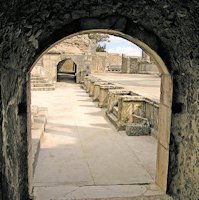
|
Some Common Myths Thought to be True - Myth 2
Myth 2: The Vomitorium was Part a Roman Dining Custom
A vomitorium is a passage situated below or behind a tier of seats in an
amphitheatre or a stadium, through which big crowds can exit rapidly at the end
of a performance. They can also be pathways for actors to enter and leave
stage. The Latin word vomitorium, plural vomitoria, derives from the verb
vomeo, vomere, vomitum, "to spew forth." In ancient Roman architecture,
vomitoria were designed to provide rapid egress for large crowds at
amphitheatres and stadiums, as they do in modern sports stadiums and large
theatres.
|
| Roman Vomitorium | |
|
There is a common misconception that ancient Romans designated spaces called
vomitoria for the purpose of actual vomiting, as part of a binge and purge
cycle. According to Cicero, Julius Caesar escaped an assassination attempt
because he felt ill after dinner. Instead of going to the latrine, where his
assassins were waiting, he went to his bedroom and avoided assassination. This
may be the origin of the misconception. The term vomitorium does not appear
until the 4th century AD, about 400 years after Caesar and Cicero.
|
|
| ⇦ Back to Myth 1 Return to Myth Choices Page 1 On to Myth 3 ⇨ | |